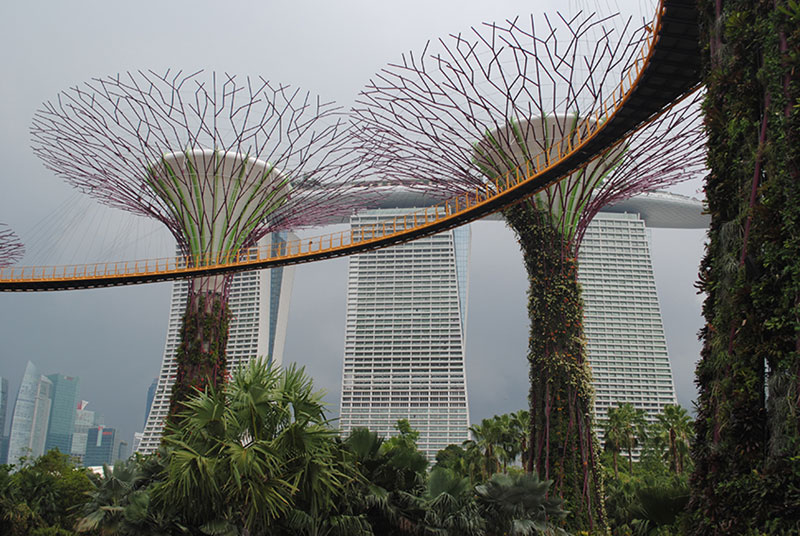
Singapore is an island city-state in Asia. Its territory consists of approximately 60 small islands and a population of just over 5 million. Singapore acquired its independence in 1965 and it is remarkable how much the country has transformed in less than a century. Between the first half of the 19th century and 1942, Singapore was a British colony. During the second world war, there was the Japanese occupation which led to a period of oppression and scarcity in the country. In 1945, after the Japanese surrender to the Allies, the country returned to British rule until it was annexed to Malaysia, from 1963 to 1965.
Singapore is known as one of the Four Asian Tigers and is ranked among the Top Five Global Financial Centres according to the GFCI. Besides the financial services, its economy relies strongly on oil refining and manufacturing. Singapore also invests heavily in tourism, receiving around 15 million visitors annually. This number is highly due to business tourism through events and conferences, but also to the city’s many attractions such as museums, parks, restaurants and architectural icons.
Chinatown

Around 70% of Singapore residents are of Chinese descent. In addition to China and Malaysia, we also notice a strong Indian influence. These cultures’ presence is so notable that their communities are organized in neighbourhoods known as ‘Little India’ and ‘Chinatown’. In ‘Chinatown’ we find several temples dedicated to different religions, such as Buddhism and Hinduism.


In Chinatown we find the traditional ‘shophouses’, small buildings with shops on the ground floor and living unit on the upper floor. Since the neighbourhood is close to the city’s financial centre, there is a contrast between these historical shophouses and glass skyscrapers. In terms of heritage, one might question this stark contrast on the urban landscape. On the other hand, seeing as there is not much free space for expansion in Singapore, there is a need for constant urban renewal.

Chinatown is currently going through this renovation process. Several shophouses are being transformed into restaurants, shops and offices, turning the neighbourhood into a new hot spot, especially among the younger generation.
Asia’s Green City

Shortly after Singapore’s independence in the 1970s, the government established an ongoing policy for green urban areas within the city. Parks such as the ‘Jurong Bird Park’ (opened in 1971) and the Singapore Zoo (opened in 1973) were a few of this initiative’s outcomes.
In the early 1990s, the Revised Concept Plan for Singapore (1991) was launched, a master plan that included a model called ‘the Green and Blue Plan’. This model identified green open spaces and waterways in the city that could be interconnected in order to regenerate and preserve biodiversity, creating thus a ‘green and blue’ corridor. Green corridors usually span through different neighbourhoods, providing greater access for the population, as well as a gradual transition in terms of landscape. Not to mention that continuous green areas allow the migration of local fauna, such as birds and insects.
Singapore is regarded as ‘a city in a garden’. In 2011, it was considered the greenest city in Asia by the Asian Green City Index. One of the city’s most recent endeavours, which highlights the importance of environmental policies, is the ‘Gardens by the Bay’.
Gardens by the Bay

The Gardens by the Bay project was the result of an international competition held in 2006 and won by British office Grant Associates. The Gardens were officially open in 2011 and it includes several venues which emphasize the importance of preserving the natural environment.
Among its main attractions, the gardens include two of the world’s largest greenhouses – the Cloud Forest and the Flower Dome. The Cloud Forest recreates the humid forest’s environment, typical of the equatorial climate, and even has an artificial waterfall inside. Towards the end of the visit, there is a presentation with a series of informative videos on the effects of climate change and global warming on our planet.

The “Flower Dome” is the other greenhouse where thousands of different flower species are assembled. Here I saw some of the most beautiful tulips I have ever seen.



In addition to thematic gardens, there is the “Supertree Grove”, vertical gardens on metallic structures which resemble gigantic trees.


Next to the Gardens stands the Marina Bay Sands hotel, an iconic project by Safdie Architects. The project is composed by three towers connected by a single 65 meter long roof. Safdie Architects is also responsible for the Jewel Changi airport project, awarded 2020 public building of the year by Archdaily.

Singapore is a city that is under the influence of several cultures simultaneously and from this mix, creates its own identity. It is a place where the natural environment and high technology come together, where there is a constant dialogue between heritage and urban renovation.


